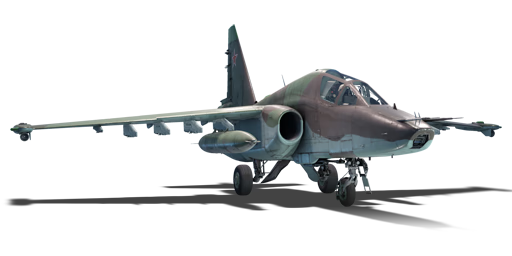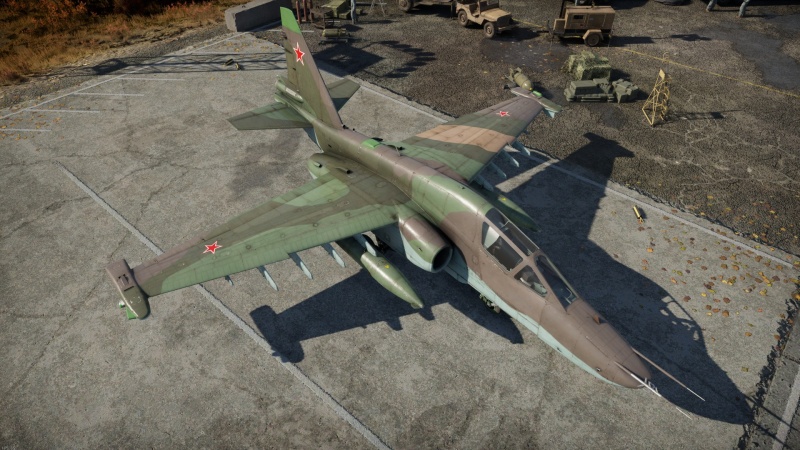Su-25T
| This page is about the Soviet strike aircraft Su-25T. For other versions, see Su-25 (Family). |
Contents
Description
The Su-25T is a rank Soviet strike aircraft with a battle rating of (AB), (RB), and (SB). It was introduced in Update "La Royale".
General info
Flight performance
Describe how the aircraft behaves in the air. Speed, manoeuvrability, acceleration and allowable loads - these are the most important characteristics of the vehicle.
| Characteristics | Max speed (km/h at _,___ m) |
Max altitude (metres) |
Turn time (seconds) |
Rate of climb (metres/second) |
Take-off run (metres) | |||
|---|---|---|---|---|---|---|---|---|
| AB | RB | AB | RB | AB | RB | |||
| Stock | ___ | ___ | __._ | __._ | __._ | __._ | ___ | |
| Upgraded | ___ | ___ | __._ | __._ | __._ | __._ | ||
Details
| Features | |||||
|---|---|---|---|---|---|
| Combat flaps | Take-off flaps | Landing flaps | Air brakes | Arrestor gear | Drogue chute |
| _ | _ | _ | _ | _ | _ |
| Limits | ||||||
|---|---|---|---|---|---|---|
| Wings (km/h) | Gear (km/h) | Flaps (km/h) | Max Static G | |||
| Combat | Take-off | Landing | + | - | ||
| ___ | ___ | ___ | ~__ | ~__ | ||
| Optimal velocities (km/h) | |||
|---|---|---|---|
| Ailerons | Rudder | Elevators | Radiator |
| < ___ | < ___ | < ___ | - |
Engine performance
| Engine | Aircraft mass | |||||
|---|---|---|---|---|---|---|
| Engine name | Number | Basic mass | Wing loading (full fuel) | |||
| _____ | _ | _,___ kg | ___ kg/m2 | |||
| Engine characteristics | Mass with fuel (no weapons load) | Max Gross Weight | ||||
| Weight (each) | Type | _m fuel | __m fuel | __m fuel | ||
| ___ kg | ___ | _,___ kg | _,___ kg | _,___ kg | _,___ kg | |
| Maximum engine thrust @ 0 m (RB/SB) | Thrust to weight ratio @ 0 m (___%/WEP) | |||||
| Condition | 100% | ___%/WEP | _m fuel | __m fuel | __m fuel | MGW |
| Stationary | ___ kgf | ___ kgf | _.__ | _.__ | _.__ | _.__ |
| Optimal | ___ kgf (_ km/h) |
___ kgf (_ km/h) |
_.__ | _.__ | _.__ | _.__ |
Survivability and armour
Examine the survivability of the aircraft. Note how vulnerable the structure is and how secure the pilot is, whether the fuel tanks are armoured, etc. Describe the armour, if there is any, and also mention the vulnerability of other critical aircraft systems.
Modifications and economy
Armaments
| Ballistic Computer | |||
|---|---|---|---|
| CCIP (Guns) | CCIP (Rockets) | CCIP (Bombs) | CCRP (Bombs) |
| |
|
|
|
Offensive armament
The Su-25T is armed with:
- A choice between two presets:
- 1 x 30 mm GSh-30-2 cannon, belly-mounted (200 rpg)
- 1 x 30 mm GSh-30-2 cannon + 192 x countermeasures
Suspended armament
Describe the aircraft's suspended armament: additional cannons under the wings, bombs, rockets and torpedoes. This section is especially important for bombers and attackers. If there is no suspended weaponry remove this subsection.
The Su-25T can be outfitted with the following ordnance presets:
- Without load
- 2 x 800 liters drop tanks
- 2 x R-60M missiles
- 32 x 100 kg OFAB-100 bombs (3,200 kg total)
- 8 x 250 kg OFAB-250sv bombs (2,000 kg total)
- 8 x 250 kg OFAB-250Sh bombs (2,000 kg total)
- 8 x 500 kg FAB-500M-62 bombs (4,000 kg total)
- 8 x 500 kg FAB-500Sh bombs (4,000 kg total)
- 2 x 500 kg KAB-500Kr bombs (1,000 kg total)
- 8 x ZB-500 incendiary bombs
- 160 x S-8KO rockets
- 40 x S-13OF rockets
- 8 x S-24B rockets
- 8 x S-25O rockets
- 4 x S-25L rockets
- 4 x Kh-25ML missiles
- 2 x Kh-29L missiles
- 2 x Kh-29T missiles
- 16 x 9K127 Vikhr missiles
- 4 x 23 mm GSh-23L cannons (250 rpg = 1,000 total)
Usage in battles
The SU-25T Frogfoot is best suited for ground attack in general, using similar low and fast passes, with the new guided munitions coming into play, especially the Vikhr missiles that have the potential to wipe ground units. It's also very survivable thanks to its sturdy airframe. In air battles, you are at a major disadvantage as aircraft you'll usually face have radar missiles that are advance, along with pulse Doppler radar. You will not outrun or catch any opponents. R-60M missiles are still decent, though they have to be conserved and used carefully. You can still dogfight enemies but the majority of vehicles, especially the F-14s, F-16s and MiG-29s of top tier can still dance around you easily. At best, try to avoid confrontation, fly to the side and low, aiming for ground targets such as AAA, howitzers and light pillboxes or bombing bases if you can get there in time. IRCM will help, though it is best to use in tandem with countermeasures, as the IRCM is not guaranteed to spoof missiles, especially at close range.
Pros and cons
Pros:
- Slightly upgraded flight performance, with a newer engine
- Engines can be overclocked too 104 percent throttle for extra thrust
- Can equip Kh-29Ts and 9K127 Vihkr missiles for ground attack
- IRCM jammer that can disrupt air-to-air missiles, along with a good amount of countermeasures
- Sturdy airframe, can survive missile hits from Stingers
- Upgraded RWR, can pinpoint radar pings accurately
- Large weaponry option, with different and unique combinations
Cons:
- Slow aircraft and heavy aircraft, especially with ordnance
- IRCM cannot stop missiles that have IRCCM such as Stingers
- Only two R-60Ms for self-defence
- Can overspeed and overheat the engines if not careful with the throttle
- Mediocre manoeuvrability
- Controls compress at high speeds
History
The Su-25T project was an attempt to create an anti-tank aircraft that would be able to operate both during the daytime and at night, equipped with targeting systems and guided munitions to defeat armored vehicles. The list of equipment for the future aircraft was formalized in 1979, it was based on the Shkval targeting and navigation system and the Mercury television sight. The prototype passed the factory tests in 1987, by 1990 the project was prepared for mass production but due to the collapse of the USSR it did not start. A small batch of completed aircraft took part in the Chechen War in 1996. After the transfer of the production base from Tbilisi, Georgia to Ulan-Ude, Russia, the project was re-focused for export. An export version with slightly different avionics was designated the Su-39. In total, three attack aircraft of this configuration were built. Due to lack of funding, the project was closed.
- From Devblog
Media
- Videos
See also
- Related development
External links
| Sukhoi Design Bureau (Сухого Опытное конструкторское бюро) | |
|---|---|
| Jet fighters | Su-9 · Su-11 |
| Su-27 | Su-27 · Su-27SM |
| Strike aircraft | |
| Su-2 | BB-1 · Su-2 (M-82) · Su-2 MV-5 · Su-2 TSS-1 |
| Su-6 | Su-6 · Su-6 (AM-42) · Su-6 (M-71F) |
| Su-7 | Su-7B · Su-7BKL · Su-7BMK |
| Su-8 | Su-8 |
| Su-17 | Su-17M2 · Su-17M4 · Su-22M3 |
| Su-24 | Su-24M |
| Su-25 | Su-25 · Su-25BM · Su-25K · Su-25T · Su-25SM3 · Su-39 |
| Su-34 | Su-34 |
| Export | ◊Su-22UM3K · ◔Su-22M3 · ◊Su-22M4 · ◄Su-22M4 WTD61 |
| J-11* | |
| *CKD and SKD kits assembled by Shenyang Aircraft Corporation | |
| USSR jet aircraft | |
|---|---|
| Bereznyak-Isayev | BI |
| Yakovlev | Yak-15 · Yak-15P · Yak-17 · Yak-23 · Yak-28B · Yak-30D · Yak-38 · Yak-38M · Yak-141 |
| Mikoyan-Gurevich | MiG-9 · MiG-9 (l) · MiG-15 · MiG-15bis · MiG-15bis ISh · MiG-17 · MiG-17AS · MiG-19PT |
| MiG-21F-13 · MiG-21PFM · MiG-21S (R-13-300) · MiG-21SMT · MiG-21bis | |
| MiG-23M · MiG-23ML · MiG-23MLD · MiG-27M · MiG-27K | |
| MiG-29 · MiG-29SMT | |
| Lavochkin | La-174 · La-15 · La-200 |
| Sukhoi | Su-9 · Su-11 |
| Su-7B · Su-7BKL · Su-7BMK · Su-17M2 · Su-17M4 · Su-22M3 | |
| Su-24M | |
| Su-25 · Su-25BM · Su-25K · Su-25T · Su-25SM3 · Su-39 | |
| Su-27 · Su-27SM | |
| Su-34 | |
| Ilyushin | IL-28 · IL-28Sh |
| Tupolev | Tu-14T |





